37 Days in Vietnam — A Navy corpsman with the U.S. Marines

On January 28, 1966, the 3rd Battalion, 1st Marines landed in Quang Ngai Province, South Vietnam at the beginning of Operation Double Eagle, the first amphibious landing in a combat theatre since the marines landed at Inchon in the Korean War. I was a navy hospital corpsman with Headquarters & Service Company. We weren’t told that Quang Ngai Province had been a communist stronghold since the beginning of the First Indochina War in 1945.
Double Eagle I & II
We would “hump the boonies” without a break until February 17, when Operation Double Eagle segued into Double Eagle II, and I had been transferred to Lima Company. We would continue humping the boonies until early March, still without a break.
Both operations were intended to destroy the “VC” — the Viet Cong. We thought of the VC as illiterate farmers armed with antique weapons, not the formidable opponents they actually were. But our enemy wasn’t just the VC. Not until March did we enlisted men learn that units of the Vietnam People’s Army (VPA), which we called the NVA, or North Vietnamese Army had infiltrated Quang Ngai Province from North Vietnam. In 1954, they and their fathers had destroyed the French army at Dien Bien Phu. Now they were fighting us, and had absolute belief in their ultimate victory.1
We rarely saw our enemy, but they saw us. Only hours after our landing, a sniper’s bullet plowed a deep groove across the top of a marine’s head. He survived, but from then on we suffered KIAs and WIAs from snipers, mortars, booby traps, mines, and “friendly fire”. We even had one MIA.
We killed and captured both VC and NVA soldiers. We tried to protect civilians, but we weren’t much good at it: armies are more about destroying the enemy than winning hearts and minds, much less providing basic necessities and medical care to civilians.
Fighting heatstroke, rain, leeches, rust, and fungus
We lived in the dirt, slept in holes if we were lucky (we had no tents or sleeping bags, and sleeping in a hole provided some protection from enemy mortars), or slept on the ground, fearfully.
We marched without apparent purpose in chilling northeast monsoon rains, suffered heatstroke with the arrival of the southwest monsoon, pulled leeches from our legs, ate little but field rations, and fought rust on our weapons and fungus on our bodies.
Marines were “zapped,” never killed or wounded
Our laughter was mostly sardonic — Vietnam was not funny place. We didn’t speak of death, but of being “zapped,” as if euphemisms couldn’t maim or kill. If we thought of the worst possibilities — wounds that would destroy normal life, especially our sexual life, we didn’t give voice to our thoughts. But we did think about those possibilities; Vietnam was a clear and present danger 24 hours a day, seven days a week. On my 37th day in country, the odds caught up with me and I was “zapped”.
Now, almost five decades later, disabled by physical and psychological wounds, I have woven together my own fading memories and the knowledge of other Vietnam veterans, commentators, and historians. The result is a patchwork quilt that illustrates our widely varying experiences before, during, and after the war. My wish is that it will serve as a memorial to those good men of 3/1 who landed on the shores of South Vietnam in 1966 but never went home.
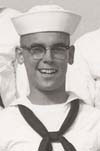
Becoming a Marine tells the story of my enlistment in the U.S. Navy and my training as a hospital corpsman that led to my orders to report to the 1st Marines at Camp Pendleton.
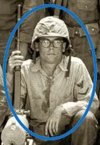
The Helmet Strap is the story of the day that I defied a direct order to fasten my helmet strap. I had my reasons: How could the Marine Corps expect me to act the part of a marine if they didn’t let me dress like a marine?!

37 Days in Vietnam — Photographs by a marine corpsman: Before 3/1 landed in Vietnam, enlisted Marines and corpsmen were ordered to turn their cameras in to our company commanders. I ignored that order. This slideshow documents our experiences in Vietnam as well as our training in California and Okinawa.

The 3/1 Cruisebook, the equivalent of a high school or college yearbook, includes portraits of nearly every officer and enlisted man in 3/1, as well as a brief battalion history, a casualty list, and photographs taken throughout the cruise.

Operation Utah didn’t have a name on March 4, 1966 when U.S. marines engaged elements of the 36th Infantry Regiment of the Peoples Vietnam Army and Viet Cong “Main Force” units in Quang Ngai Province, South Vietnam. It was the the first encounter between the Marines and North Vietnamese soldiers. By the end of the day on March 5, the marines had prevailed, but at great cost.
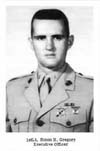
In Command — 1st Lt. Simon Gregory & the Battle for Hill 50 is the first-person account of how the new commander of Lima Company, 3/1 met the challenge of an unexpected and fierce attack by heavily armed and solidly entrenched North Vietnamese and Viet Cong units on March 5, 1966, the second day of Operation Utah.
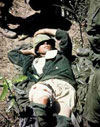
Corpsman Down, published in the March/April, 2006 issue of Navy Medicine, is my first-person account about being wounded in South Vietnam on March 5, 1966, and about my treatment and healing at Balboa Naval Hospital in San Diego. I wish to thank former Navy Medicine editor Jan Herman for encouraging me to write about my experiences.

Corpsman up! Hospitalman Larry Skonetski in Vietnam is an appreciation of a man who became the most important person in my life on March 5, 1966 after I had been seriously wounded. Larry, the first corpsman to reach me, probably didn’t save my life, but he gave me hope, risking his own life when death for all of us seemed imminent. Decades later, barely in time, I was finally able to thank him for his professionalism and his comradeship.
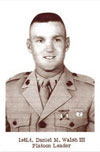
Dan Walsh receives his Bronze Star—belatedly: The story of a remarkable marine who, 32 years to the day after the Battle for Hill 50 in Operation Utah, received a Bronze Star medal with a “V” for Valour.

The 3rd Battalion, 1st Marines Casualty List includes the names of the battalion’s 107 enlisted marines and officers who were killed in South Vietnam in 1966, most of them in combat. The battalion lost more than 10 per cent of its original combat strength during its tour of duty. In an historical sense, it was truly decimated; in the Ancient Roman army, group punishment was sometimes carried out by executing one out of every ten soldiers
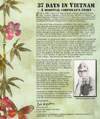
My exhibit, 37 Days in Vietnam — A hospital corpsman’s story won a silver-medal at the 2007 Vancouver Philatelic Exhibition (VANPEX 2007).
-
For Communist North Vietnam, the regions that Americans knew as South Vietnam and North Vietnam, created by the Geneva Conference in 1954, didn’t exist. The Communist leader, Ho Chi Minh, had succeeded in ending French colonial rule in Indochina, but unification of the northern and southern parts of the country eluded him. A nationwide election that undoubtedly would have united north and south was sabotaged by the Americans, who supported the government of South Vietnam, at first with weapons, money, military advisors, and air strikes against North Vietnamese targets, then with the commitment of U.S. ground troops in 1965. In 1975, following the withdrawal of American aid and military presence, Communist forces captured Saigon. Fourteen months later, the Socialist Republic of Vietnam was proclaimed, formally ending the existence of the “two Vietnams”. ↩︎